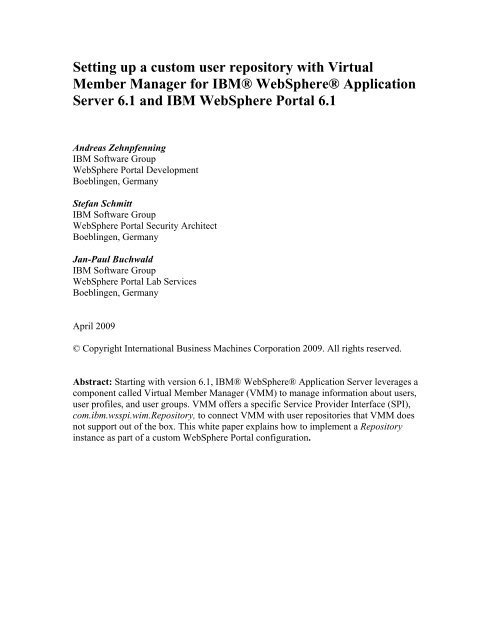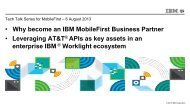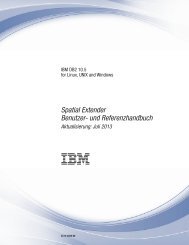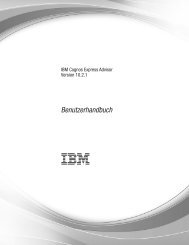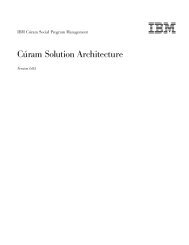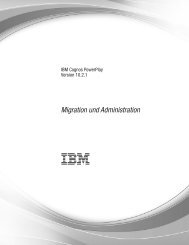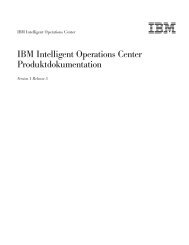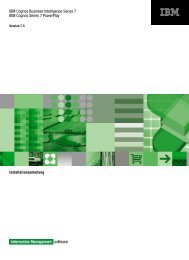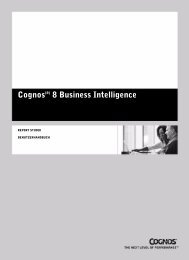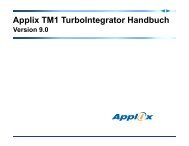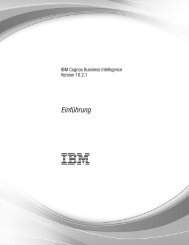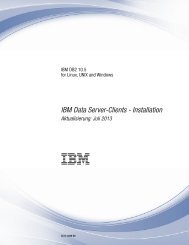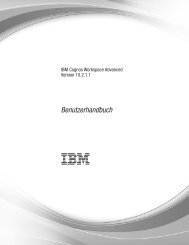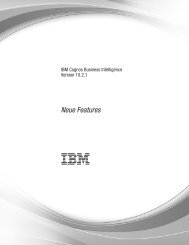Setting up a custom user repository with Virtual Member Manager for ...
Setting up a custom user repository with Virtual Member Manager for ...
Setting up a custom user repository with Virtual Member Manager for ...
You also want an ePaper? Increase the reach of your titles
YUMPU automatically turns print PDFs into web optimized ePapers that Google loves.
<strong>Setting</strong> <strong>up</strong> a <strong>custom</strong> <strong>user</strong> <strong>repository</strong> <strong>with</strong> <strong>Virtual</strong><br />
<strong>Member</strong> <strong>Manager</strong> <strong>for</strong> IBM® WebSphere® Application<br />
Server 6.1 and IBM WebSphere Portal 6.1<br />
Andreas Zehnpfenning<br />
IBM Software Gro<strong>up</strong><br />
WebSphere Portal Development<br />
Boeblingen, Germany<br />
Stefan Schmitt<br />
IBM Software Gro<strong>up</strong><br />
WebSphere Portal Security Architect<br />
Boeblingen, Germany<br />
Jan-Paul Buchwald<br />
IBM Software Gro<strong>up</strong><br />
WebSphere Portal Lab Services<br />
Boeblingen, Germany<br />
April 2009<br />
© Copyright International Business Machines Corporation 2009. All rights reserved.<br />
Abstract: Starting <strong>with</strong> version 6.1, IBM® WebSphere® Application Server leverages a<br />
component called <strong>Virtual</strong> <strong>Member</strong> <strong>Manager</strong> (VMM) to manage in<strong>for</strong>mation about <strong>user</strong>s,<br />
<strong>user</strong> profiles, and <strong>user</strong> gro<strong>up</strong>s. VMM offers a specific Service Provider Interface (SPI),<br />
com.ibm.wsspi.wim.Repository, to connect VMM <strong>with</strong> <strong>user</strong> repositories that VMM does<br />
not s<strong>up</strong>port out of the box. This white paper explains how to implement a Repository<br />
instance as part of a <strong>custom</strong> WebSphere Portal configuration.
Contents<br />
1 Introduction .................................................................................................................... 3<br />
2 WebSphere Portal's use of VMM ............................................................................... 3<br />
3 VMM Overview .............................................................................................................. 5<br />
3.1 Types of in<strong>for</strong>mation managed by VMM ............................................................ 5<br />
3.1.1 Authentication in<strong>for</strong>mation................................................................................ 5<br />
3.1.2 Gro<strong>up</strong> membership............................................................................................. 6<br />
3.1.3 User profile ........................................................................................................ 7<br />
3.1.4 Property Extension <strong>repository</strong>............................................................................ 7<br />
3.2 VMM concepts ....................................................................................................... 8<br />
3.2.1 VMM functions.................................................................................................. 8<br />
3.2.2 DataObjects........................................................................................................ 9<br />
3.2.3 <strong>Virtual</strong> <strong>Member</strong> <strong>Manager</strong> unique identifiers ..................................................... 9<br />
3.2.4 Attributes in VMM .......................................................................................... 10<br />
3.3 Mapping <strong>user</strong> profile attributes to the <strong>user</strong> <strong>repository</strong> ................................... 11<br />
3.4 Configuration files <strong>for</strong> VMM................................................................................ 11<br />
3.4.1 Main configuration file: wimconfig.xml.......................................................... 11<br />
3.4.2 Additional <strong>custom</strong> attributes: wimxmlextension.xml...................................... 13<br />
4 Implementing a <strong>custom</strong> <strong>repository</strong> ........................................................................... 13<br />
4.1 Comparing WMM and VMM .............................................................................. 13<br />
4.2 Methods of the Repository interface................................................................. 15<br />
4.2.1 Methods <strong>for</strong> retrieving entities......................................................................... 15<br />
4.2.2 Creating new entities........................................................................................ 19<br />
4.2.3 Deleting entities ............................................................................................... 20<br />
4.2.4 Getting meta data ............................................................................................. 21<br />
4.2.5 Logging in........................................................................................................ 22<br />
4.2.6 Searching <strong>for</strong> entities ....................................................................................... 23<br />
4.2.7 Updating attributes and membership in<strong>for</strong>mation ........................................... 24<br />
4.2.8 Initializing the <strong>repository</strong>................................................................................. 27<br />
4.2.9 Creating a new attribute definition .................................................................. 28<br />
5 <strong>Setting</strong> <strong>up</strong> a <strong>custom</strong> <strong>repository</strong> ................................................................................. 28<br />
5.1 Using the <strong>custom</strong> <strong>repository</strong> <strong>with</strong>in a federated <strong>repository</strong>........................... 28<br />
5.1.1 Add <strong>custom</strong> <strong>repository</strong> as additional federated <strong>repository</strong> .............................. 28<br />
5.1.2 Assign administrator role to <strong>user</strong> in <strong>custom</strong> <strong>repository</strong> (optional) .................. 30<br />
5.1.3 Delete other repositories from VMM configuration (optional) ....................... 30<br />
5.2 Using the <strong>custom</strong> <strong>repository</strong> as a standalone registry................................... 31<br />
6 Tips and tricks ............................................................................................................. 32<br />
Constants................................................................................................................... 32<br />
Utility classes............................................................................................................ 32<br />
7 Verifying your implementation .................................................................................. 33<br />
8 The File Repository sample adapter........................................................................ 33<br />
8.1 Architecture .......................................................................................................... 33<br />
9 Conclusion ................................................................................................................... 34<br />
10 Resources.................................................................................................................. 35<br />
11 About the authors ..................................................................................................... 35
1 Introduction<br />
In this paper, the term “<strong>custom</strong> <strong>user</strong> <strong>repository</strong>” refers to any <strong>user</strong> or gro<strong>up</strong> data store that<br />
is not natively s<strong>up</strong>ported by WebSphere Application Server and <strong>Virtual</strong> <strong>Member</strong><br />
<strong>Manager</strong>. Also, unless otherwise indicated, any statement about “<strong>user</strong>s” also applies to<br />
gro<strong>up</strong>s in the <strong>user</strong> <strong>repository</strong>. Users and gro<strong>up</strong>s are also called “entities”.<br />
Starting <strong>with</strong> version 6.1, WebSphere Application Server leverages a component called<br />
<strong>Virtual</strong> <strong>Member</strong> <strong>Manager</strong> (VMM) to manage in<strong>for</strong>mation about <strong>user</strong>s, <strong>user</strong> profiles, and<br />
<strong>user</strong> gro<strong>up</strong>s. As a result, <strong>user</strong> management in WebSphere Portal 6.1 is based on this<br />
component and no longer uses WebSphere <strong>Member</strong> <strong>Manager</strong> (WMM).<br />
VMM offers a specific Service Provider Interface (SPI), com.ibm.wsspi.wim.Repository,<br />
to connect VMM (and there<strong>for</strong>e both WebSphere Application Server and WebSphere<br />
Portal) <strong>with</strong> <strong>user</strong> repositories that VMM does not s<strong>up</strong>port out of the box. This SPI is the<br />
replacement <strong>for</strong> the corresponding interface<br />
com.ibm.websphere.wmm.adapter.<strong>Member</strong>Repository that addressed this use case in<br />
WMM.<br />
Despite the fact that the interface addresses the same use case, the Repository interface in<br />
WebSphere Portal 6.1 is much different than the old WebSphere <strong>Member</strong> <strong>Manager</strong><br />
<strong>Member</strong>Repository interface.<br />
The new interface does not s<strong>up</strong>port backward compatibility <strong>with</strong> the old interface,<br />
meaning that existing <strong>Member</strong>Repository implementations under WebSphere Portal<br />
V5.x/6.0.x must be ported to the new interface definition. We explain the differences and<br />
give detailed examples in this document.<br />
Just as it was in WMM, all the out-of-the-box-s<strong>up</strong>ported <strong>user</strong> stores (various LDAP<br />
servers, a database <strong>repository</strong>, and the VMM file <strong>repository</strong>) are accessed through IBMs<strong>up</strong>plied<br />
implementations of the same Repository interface that <strong>custom</strong>ers can implement<br />
<strong>for</strong> their own unique <strong>user</strong> <strong>repository</strong>. This means that this code path has been thoroughly<br />
tested.<br />
Note that an implementation of the Repository interface is called a “<strong>repository</strong> adapter”.<br />
2 WebSphere Portal's use of VMM<br />
The APIs exposed by VMM provide an abstract, object-oriented view of <strong>user</strong>s and gro<strong>up</strong>s<br />
to WebSphere Portal and all portlets that are installed on WebSphere Portal. Details of<br />
the individual <strong>repository</strong>-specific implementations and data layouts remain transparent to<br />
code leveraging these APIs.<br />
WebSphere Portal v6.1 still uses the public version of Portal User Management<br />
Architecture (PUMA) API code on top of VMM. This implementation detail of PUMA is<br />
not important <strong>for</strong> the process of implementing a <strong>repository</strong> adapter under VMM, but it
will be important <strong>for</strong> accessing <strong>user</strong> profile in<strong>for</strong>mation in <strong>custom</strong>-written portlets or<br />
other WebSphere Portal code.<br />
As the portal and portlets use PUMA to do searches and to get and set attributes on the<br />
User object, PUMA passes these requests to the corresponding methods of VMM—which<br />
in turn passes them to the corresponding <strong>repository</strong> adapter.<br />
Figure 1 shows a software stack in which PUMA is always calling the VMM component<br />
<strong>for</strong> <strong>user</strong> and gro<strong>up</strong> in<strong>for</strong>mation and management. Authentication in<strong>for</strong>mation is built by<br />
WebSphere Application Server Security infrastructure by calling the User Registry <strong>for</strong> an<br />
explicit log-in, or in case of single sign-on scenarios, via implicit log-in.<br />
Figure 1. Software stack <strong>for</strong> <strong>user</strong> management<br />
The VMM component can aggregate a set of adapters (the standard File, LDAP, and DB<br />
adapters, and <strong>custom</strong> <strong>repository</strong> adapters as described in this paper), allowing multiple<br />
repositories to be configured.<br />
The User Registry defined <strong>for</strong> the WebSphere Application Server context can be<br />
configured <strong>for</strong> one of the following three implementations:<br />
• <strong>Virtual</strong> <strong>Member</strong> <strong>Manager</strong> Federated Repositories. In this implementation, all<br />
operations of the User Registry are dispatched to the VMM component also. When<br />
defining a federated <strong>repository</strong>, you can specify whether VMM only dispatches the<br />
code calls to the different repositories, or uses a database to store mappings of<br />
external identifiers (used by the repositories) and internal identifiers (used by VMM).
• Standalone LDAP adapter. This allows WebSphere Application Server to integrate<br />
<strong>with</strong> a single LDAP directly. If you choose this option, you still must configure VMM<br />
appropriately <strong>for</strong> the WebSphere Portal-related part.<br />
• Custom User Registry. This is a <strong>custom</strong> implementation of the UserRegistry<br />
interface and is also independent of the VMM part. In scenarios in which both<br />
WebSphere Application Server applications and WebSphere Portal must be integrated<br />
<strong>with</strong> <strong>custom</strong> security backends, the combination of Custom User Registry and<br />
Custom Repository Adapter is usually used (described in more detail below).<br />
3 VMM Overview<br />
VMM (as accessed through PUMA) is the abstract interface that WebSphere Portal v6.1<br />
uses to access <strong>user</strong> and gro<strong>up</strong> in<strong>for</strong>mation. This includes the <strong>user</strong> accounts that tell<br />
WebSphere Portal that the <strong>user</strong> exists, the enclosing <strong>user</strong> gro<strong>up</strong>s of which the given <strong>user</strong><br />
might be a member, and the individual attributes of that <strong>user</strong>. Attributes include<br />
in<strong>for</strong>mation about the <strong>user</strong> such as <strong>user</strong> name, job title, or location.<br />
3.1 Types of in<strong>for</strong>mation managed by VMM<br />
In WebSphere Portal v6.1, VMM manages three types of in<strong>for</strong>mation about <strong>user</strong>s:<br />
• Authentication in<strong>for</strong>mation<br />
• The <strong>user</strong>'s memberships in <strong>user</strong> gro<strong>up</strong>s<br />
• The <strong>user</strong> profile<br />
WebSphere Portal also keeps other in<strong>for</strong>mation on a per-<strong>user</strong> basis outside of the VMM<br />
component (and there<strong>for</strong>e not as part of "the <strong>user</strong> profile" in our definition). For example,<br />
the <strong>custom</strong>izations that a <strong>user</strong> makes to a portlet are stored in portlet instance data in the<br />
WebSphere Portal database.<br />
This in<strong>for</strong>mation is not actually part of the VMM-managed <strong>user</strong> profile, even though this<br />
portlet instance data is in some sense "keyed" by the identity of the <strong>user</strong> (the <strong>user</strong> DN, or<br />
some other unique identifier <strong>for</strong> that <strong>user</strong>). This also includes access control in<strong>for</strong>mation,<br />
which is stored <strong>with</strong>in a separate authorization component in WebSphere Portal.<br />
3.1.1 Authentication in<strong>for</strong>mation<br />
The actual authentication is not en<strong>for</strong>ced by WebSphere Portal itself, but by WebSphere<br />
Application Server, which in turn may further dispatch this en<strong>for</strong>cement to a separate<br />
authentication proxy server, depending on the security configuration of WebSphere<br />
Portal.<br />
The authentication process itself typically involves calling the User Registry to verify the<br />
<strong>user</strong> credentials prior to building the corresponding security context. Furthermore, the
application server will call the <strong>user</strong> registry during en<strong>for</strong>cement of J2EE authorization<br />
constraints to retrieve gro<strong>up</strong> membership in<strong>for</strong>mation.<br />
VMM provides an implementation of the com.ibm.websphere.security.UserRegistry<br />
interface—the Federated repositories. If WebSphere Application Server is configured to<br />
use this implementation, then all the <strong>user</strong> repositories configured <strong>for</strong> VMM are<br />
automatically available <strong>for</strong> the log-in.<br />
This means that you do not have to develop a <strong>custom</strong> implementation of the UserRegistry<br />
interface if you have a <strong>custom</strong> <strong>user</strong> <strong>repository</strong>; that is, implementing<br />
com.ibm.wsspi.wim.Repository is sufficient even <strong>for</strong> log-in. If, however, the Application<br />
Server is configured to use a different implementation of<br />
com.ibm.websphere.security.UserRegistry, you must ensure that VMM is configured to<br />
use the same <strong>user</strong> <strong>repository</strong> as this implementation does.<br />
When a person logs in to WebSphere Portal, their <strong>user</strong> account is defined <strong>with</strong>in the <strong>user</strong><br />
data store that the User Registry implementation is using. For example, if federated<br />
repositories is used and VMM is configured towards an LDAP, then an LDAP <strong>user</strong> object<br />
(typically, an inetOrgPerson object instance) represents the <strong>user</strong> account. Such <strong>user</strong><br />
objects usually have a password that protects that account from unauthorized access.<br />
3.1.2 Gro<strong>up</strong> membership<br />
The same <strong>user</strong> data store that holds the account in<strong>for</strong>mation is usually the source of<br />
gro<strong>up</strong> membership in<strong>for</strong>mation. In LDAP, <strong>for</strong> example, this takes the <strong>for</strong>m of directory<br />
objects that are typically of object class gro<strong>up</strong>OfNames or gro<strong>up</strong>OfUniqueNames,<br />
<strong>with</strong> membership records pointing to the distinguished name (DN) of the <strong>user</strong> objects.<br />
Note that the previous LDAP example is how VMM assumes by default that gro<strong>up</strong><br />
membership works in the underlying <strong>repository</strong> in which the members are listed as<br />
attributes of the gro<strong>up</strong>, rather than the gro<strong>up</strong>s being listed as an attribute of the members.<br />
Many directories also s<strong>up</strong>port listing the gro<strong>up</strong>s of which the <strong>user</strong> is a member as an<br />
attribute of the <strong>user</strong> object (in Active Directory, <strong>for</strong> example, this is the memberOf<br />
attribute).<br />
You can configure VMM to use this attribute when asked by WebSphere Portal <strong>for</strong> the<br />
gro<strong>up</strong>s of which a <strong>user</strong> is a member, rather than doing an LDAP search <strong>for</strong> objects of the<br />
gro<strong>up</strong> object class that have the <strong>user</strong> DN as a member record. This yields per<strong>for</strong>mance<br />
improvements <strong>for</strong> such searches.<br />
VMM will still use the member lists of gro<strong>up</strong>s when asked to enumerate "all the members<br />
of a gro<strong>up</strong>." The used data store is responsible <strong>for</strong> keeping the memberOf attribute in sync<br />
<strong>with</strong> the gro<strong>up</strong> member list, so that all gro<strong>up</strong>s in which the <strong>user</strong> is listed as a member<br />
show <strong>up</strong> on the attribute, and only gro<strong>up</strong>s in which the <strong>user</strong> is listed as a member show <strong>up</strong><br />
on the attribute.
VMM also s<strong>up</strong>ports cross-<strong>repository</strong> gro<strong>up</strong> membership; that is, a gro<strong>up</strong> can have<br />
members who are stored in a different <strong>repository</strong>. It's <strong>up</strong> to each <strong>repository</strong> whether it<br />
s<strong>up</strong>ports gro<strong>up</strong>s that have members who are not stored <strong>with</strong>in the same <strong>repository</strong>. On the<br />
other hand, it's <strong>up</strong> to the configuration to make the gro<strong>up</strong> look<strong>up</strong> <strong>for</strong> entities access other<br />
repositories. See section 3.4.1.2 <strong>for</strong> in<strong>for</strong>mation about the configuration of cross<strong>repository</strong><br />
gro<strong>up</strong>s.<br />
3.1.3 User profile<br />
The <strong>user</strong> profile is the set of named and typed attributes representing the individual<br />
properties (attributes) of individual <strong>user</strong>s. For example, the <strong>user</strong> profile might include an<br />
attribute named mailingAddress of type String, a String e-mailAddress, an Integer<br />
serialNumber, and the timestamp of when the <strong>user</strong> last logged in.<br />
All <strong>user</strong>s in WebSphere Portal and VMM share the same <strong>user</strong> profile schema. That is, all<br />
<strong>user</strong>s have the same set of attribute names as part of their profile, but will often have<br />
different values, or no value at all, <strong>for</strong> those attributes. The profile represents a template<br />
<strong>for</strong> a <strong>user</strong>, and each <strong>user</strong> profile is an instance of that template, <strong>with</strong> at least some of the<br />
attributes filled in.<br />
In VMM, the <strong>user</strong> profile is set by a list of predefined attributes that can be extended <strong>with</strong><br />
additional attributes defined in a file called wimxmlextension.xml. PUMA offers methods<br />
to retrieve the list of all defined attributes <strong>for</strong> <strong>user</strong>s and <strong>for</strong> gro<strong>up</strong>s.<br />
Passwords used <strong>for</strong> authentication are not part of the <strong>user</strong> profile, since those are<br />
considered authentication in<strong>for</strong>mation. The distinction between what is and what is not<br />
defined as part of the <strong>user</strong> profile is not really important. The password can be set<br />
through interfaces in VMM.<br />
The WebSphere Portal <strong>user</strong> self-registration and self-care portlets, and the Manage Users<br />
and Gro<strong>up</strong>s administration portlets, call VMM APIs to set the <strong>user</strong>'s password, if the<br />
<strong>custom</strong>er wants to use these WebSphere Portal facilities to do <strong>user</strong> provisioning.<br />
The passwords are not stored in the WebSphere Portal configuration database but stored<br />
<strong>with</strong> the <strong>user</strong> objects in the underlying <strong>repository</strong>. However, it is not possible to read the<br />
password from VMM as the password attribute is configured as “sensitive.”<br />
3.1.4 Property Extension <strong>repository</strong><br />
The Property Extension <strong>repository</strong>—<strong>for</strong>merly know as the Lookaside <strong>repository</strong>—is<br />
used to store entity attributes that cannot be (or that you do not want to be) stored in the<br />
main <strong>user</strong> data store, <strong>for</strong> example, the LDAP directory. VMM manages this Property<br />
Extension <strong>repository</strong> in its own database.<br />
You can easily define and add new attributes to the <strong>user</strong> profile and map them to this<br />
Property Extension <strong>repository</strong>. The attributes that are defined in the Property Extension<br />
<strong>repository</strong> are available to all <strong>user</strong>s, regardless of the <strong>repository</strong> in which they are stored.
3.2 VMM concepts<br />
Each entity stored under VMM is of a dedicated type. Entity types that are used by<br />
WebSphere Portal are PersonAccount (<strong>for</strong> <strong>user</strong>s), Gro<strong>up</strong> (<strong>for</strong> gro<strong>up</strong>s) and OrgContainer<br />
(<strong>for</strong> organizations and organizational units). Each entity has a profile describing its<br />
characteristics <strong>with</strong>in the system and differentiating one entity from another. After an<br />
entity is created, its entity type cannot be changed.<br />
For example, a Gro<strong>up</strong> cannot be changed to a PersonAccount. Each entity is a node in the<br />
entity tree (or in one of the entity trees, if there is more than one root node). VMM<br />
provides the following features:<br />
• A common mechanism to access entity profiles that are made of attributes, regardless<br />
of where and how the data of a member profile is stored. These attributes can be<br />
multi-valued and/or composite.<br />
• A set of services to act on and manage entities such as create, read, <strong>up</strong>date, remove,<br />
and search entities in <strong>user</strong> repositories. These services also s<strong>up</strong>port managing gro<strong>up</strong>s,<br />
including assigning members to and removing members from gro<strong>up</strong>s, and querying<br />
gro<strong>up</strong> membership.<br />
• A hierarchical structuring of entities.<br />
• Management of a Property Extension <strong>repository</strong> <strong>with</strong>in the VMM database to extend<br />
and augment any primary <strong>user</strong> data store.<br />
• A programmatic way to define new attributes in a <strong>user</strong> data store, if s<strong>up</strong>ported by the<br />
<strong>user</strong> data store and the Repository Adapter that connects VMM to that <strong>user</strong> data store,<br />
and if allowed by the <strong>custom</strong>er's access policies to that data store.<br />
3.2.1 VMM functions<br />
VMM s<strong>up</strong>ports various entity-related tasks, most of which are passed through to the<br />
Repository SPI to be per<strong>for</strong>med by the implementation of that interface.<br />
Entity management tasks:<br />
• Create entities <strong>with</strong>in a hierarchical structure<br />
• Retrieve the profile of an entity using a unique identifier<br />
• Search <strong>for</strong> entities based on attributes<br />
• Update entities<br />
• Remove entities<br />
Currently not used by WebSphere Portal:<br />
o Move entities <strong>with</strong>in the hierarchical structure.<br />
o Retrieve specific entities, including associations such as the ancestors and<br />
descendants of an entity in the hierarchical structure.<br />
Profile <strong>repository</strong> management tasks:
• List attribute definitions<br />
• Define new attributes (adding new attribute definitions that were not previously<br />
"part of the profile") in a profile <strong>repository</strong> programmatically.<br />
o Note that the IBM-s<strong>up</strong>plied <strong>repository</strong> adapters that use LDAP as their<br />
data store do not propagate the new attribute definitions to the LDAP<br />
server. This means that adding new attribute definitions is only useful <strong>for</strong><br />
attributes that are already defined in LDAP, but not yet in VMM.<br />
o Your <strong>repository</strong> adapter might or might not choose to s<strong>up</strong>port adding new<br />
attributes programmatically.<br />
o WebSphere Portal uses this functionality only during the configuration,<br />
not during the runtime. Additionally, the WebSphere Portal server must be<br />
restarted to make PUMA aware of the recently added attributes.<br />
• Define new attributes in a the Property extension <strong>repository</strong>, if available<br />
Gro<strong>up</strong> management tasks:<br />
• Assign members to gro<strong>up</strong>s<br />
• Remove members from gro<strong>up</strong>s<br />
• Determine if an entity belongs to a gro<strong>up</strong><br />
• List all members <strong>with</strong>in a gro<strong>up</strong><br />
• List all gro<strong>up</strong>s to which an entity belongs<br />
3.2.2 DataObjects<br />
A commonj.sdo.DataObject is a Java object wrapping some XML and, since all VMM's<br />
methods take a DataObject as input and returns a DataObject as result, the interesting<br />
question is: What do these DataObjects—the XML they contain—look like?<br />
Chapter 4 below examines each method (and each use case), providing examples <strong>for</strong> an<br />
input DataObject and <strong>for</strong> the resulting output DataObject. The examples do not cover all<br />
possible shapes s<strong>up</strong>ported by VMM, just those currently used by WebSphere Portal code.<br />
3.2.3 <strong>Virtual</strong> <strong>Member</strong> <strong>Manager</strong> unique identifiers<br />
Every entity that is managed by VMM requires a unique identifier, which allows an<br />
entity profile to be safely retrieved, preventing ambiguity. VMM provides two types of<br />
unique identifiers.<br />
The first, uniqueName, is convenient <strong>for</strong> identification and display purposes. The<br />
uniqueName is very much like a distinguished name (DN) in LDAP in that it is unique (at<br />
least <strong>with</strong>in a certain scope; in this case, <strong>with</strong>in the VMM instance name space, which<br />
might at some point encompass multiple physical <strong>user</strong> repositories) but can be changed,<br />
as long as the new value is still unique. (NOTE: The practice of changing DNs is not<br />
recommended because many applications treat them as static).<br />
After an entity has been deleted from VMM, a new entity can be created and can reuse<br />
the uniqueName of the deleted entity. An example of a uniqueName is uid=alice,o=my
Organization. Note that VMM expects at least a name/value pair (such as name=value) as<br />
the uniqueName <strong>for</strong> an entity.<br />
The uniqueId, on the other hand, is unique, static, and never reused. That is, after a<br />
uniqueId <strong>for</strong> an entity is created, the value of that uniqueId will not change; and even if<br />
the entity is deleted, a new entity cannot reuse the value of the uniqueId of the deleted<br />
entity.<br />
There<strong>for</strong>e, the uniqueName uniquely identifies an entity at a single point in time, while<br />
the uniqueId, due to its characteristic of never being reused, uniquely identifies a<br />
member over time.<br />
User repositories such as an LDAP also have the concept of unique identifiers. For<br />
instance, LDAP has a DN and a special attribute that serves as extId, such as ibmentryuuid.<br />
VMM entities store these values as externalName and externalId. Usually,<br />
VMM is configured such that the uniqueName and the <strong>user</strong> <strong>repository</strong>'s DN match, but<br />
it's possible <strong>for</strong> the <strong>repository</strong> configuration and/or implementation to define a mapping.<br />
For the uniqueId and externalId it depends on the set<strong>up</strong> of VMM. Usually, VMM uses the<br />
externalId provided by the <strong>repository</strong> adapter as uniqueId; however, if VMM is<br />
configured to use a federation database, then VMM generates its own uniqueIds and<br />
stores the mapping of uniqueId to externalId in the database.<br />
Quickly summarized, VMM is responsible <strong>for</strong> the uniqueId-to-externalId mapping,<br />
whereas the <strong>repository</strong> adapter is responsible <strong>for</strong> the externalName-to-uniqueName<br />
mapping.<br />
When planning a <strong>custom</strong> VMM adapter implementation, you should carefully consider<br />
what your implementation expects and returns as values <strong>for</strong> the uniqueName, uniqueId,<br />
externalName, and externalId attributes <strong>with</strong>in the data objects.<br />
Changing the implementation of this detail may cause inconsistencies and data loss in the<br />
WebSphere Portal database. Note that you can partially fix these by running the<br />
clean<strong>up</strong><strong>user</strong>s task (see the Sample XML configuration topic in the WebSphere Portal 6.1<br />
in<strong>for</strong>mation center.).<br />
3.2.4 Attributes in VMM<br />
VMM comes <strong>with</strong> a predefined set of attributes <strong>for</strong> <strong>user</strong>s and gro<strong>up</strong>s. PumaProfile's<br />
methods getDefinedUserAttributeNames() and getDefinedGro<strong>up</strong>AttributeNames() can be<br />
used to retrieve this set at runtime. Additionally, you can execute the ConfigEngine.bat<br />
wp-query-attribute-config task in directory wp_profile_root/ConfigEngine.<br />
If you want to define additional attributes, use the ConfigEngine.bat wp-add-property<br />
task. The additional attribute definitions are stored in wimxmlextension.xml.<br />
For further in<strong>for</strong>mation, refer to the "Adapting the attribute configuration" section in the<br />
WebSphere Portal 6.1 In<strong>for</strong>mation Center .
<strong>Member</strong>-reference attributes<br />
In addition to the more standard attribute types like Integer or String, there is a special<br />
attribute type called IdentifierType, which has a uniqueName as value and thus<br />
references another entity. For example, the attribute manager is of IdentifierType and has<br />
the uniqueName of the entity's manager as value.<br />
3.3 Mapping <strong>user</strong> profile attributes to the <strong>user</strong> <strong>repository</strong><br />
If the names of an attribute in the <strong>repository</strong> and in VMM config do not match, then it's<br />
<strong>up</strong> to the <strong>repository</strong> adapter to implement an attribute mapping. For example, the attribute<br />
ibm-primaryEmail is defined in VMM by default and is used by WebSphere Portal to<br />
store and retrieve the <strong>user</strong>s' email addresses.<br />
If this attribute is not available in your <strong>repository</strong> but the email addresses are stored in the<br />
attribute mail, then your <strong>repository</strong> adapter could translate a request <strong>for</strong> ibmprimaryEmail<br />
into a request <strong>for</strong> mail and return the value of mail as the value <strong>for</strong> ibmprimaryEmail.<br />
3.4 Configuration files <strong>for</strong> VMM<br />
There are two configuration files <strong>for</strong> VMM:<br />
• /config/cells//wim/config/wimconfig.xml<br />
• /config/cells//wim/model/wimxmlextension.xml.<br />
The *.xsd files contained in those directories provide a good clue of the possible content<br />
of the files. The most basic configuration options are discussed in the next sections.<br />
3.4.1 Main configuration file: wimconfig.xml<br />
The wimconfig.xml file is used to manage entity types, repositories, and realms.<br />
3.4.1.1 Configuring a <strong>repository</strong><br />
For each <strong>repository</strong>, wimconfig.xml contains a element. This<br />
element has an attribute adapterClassName that is used to specify which Java class<br />
implements the com.ibm.wsspi.wim.Repository interface <strong>for</strong> that <strong>repository</strong>. The attribute<br />
id assigns a unique name to this <strong>repository</strong> that is used to identify the <strong>repository</strong> in the<br />
future.<br />
As child elements, there is at least one element that specifies which DN suffix<br />
is contained in that <strong>repository</strong> and should be made available to VMM. The<br />
nameInRepository attribute is optional and can be used to define a DN mapping.<br />
In the above example, the DNs in the <strong>repository</strong> that end <strong>with</strong> o=myRoot are accessible to<br />
VMM; however, VMM adapter will replace this suffix <strong>with</strong> o=Default Organization<br />
when exposing the entities to WebSphere Portal. If WebSphere Portal asks <strong>for</strong> a <strong>user</strong><br />
uid=bob,o=DefaultOrganization, then the <strong>repository</strong> adapter will convert that DN to
uid=bob,o=myRoot and return the entity referenced by this DN—if it exists. However,<br />
the DN returned to WebSphere Portal will again be uid=bob,o=Default Organization.<br />
For a <strong>custom</strong> <strong>repository</strong> adapter, there can be any number of elements, and these name/value pairs are passed to the<br />
<strong>custom</strong> adapter during initialization.<br />
3.4.1.2 Configuring cross-<strong>repository</strong> gro<strong>up</strong> look<strong>up</strong><br />
By default, gro<strong>up</strong>s <strong>for</strong> a given entity are looked <strong>up</strong> only in the same <strong>repository</strong> in which<br />
the entity is stored. The optional parameter repositoriesForGro<strong>up</strong>s causes the specified<br />
<strong>repository</strong> to also be used <strong>for</strong> gro<strong>up</strong> look<strong>up</strong>, making it possible to have cross-<strong>repository</strong><br />
gro<strong>up</strong>s, if the corresponding <strong>repository</strong> adapter s<strong>up</strong>ports gro<strong>up</strong>s that have members stored<br />
in another <strong>repository</strong>:<br />
aReposId<br />
NOTE: If <strong>repository</strong> A has gro<strong>up</strong>s <strong>with</strong> members from <strong>repository</strong> B, but <strong>repository</strong> B is<br />
not configured to have <strong>repository</strong> A <strong>for</strong> gro<strong>up</strong> look<strong>up</strong>, then gro<strong>up</strong> membership will not be<br />
handled consistently (see figure 2).<br />
Figure 2. Cross-<strong>repository</strong> gro<strong>up</strong> look<strong>up</strong><br />
3.4.1.3 Configuring a realm<br />
The config:realmConfiguration element <strong>with</strong>in the wimconfig.xml controls the available<br />
realms and which is the default realm. Each realm is made <strong>up</strong> of one or more<br />
participatingBaseEntries, all of which must occur as a base entry in one of the<br />
repositories.<br />
Note that VMM is a bit strict here; it dictates that the very same base entry is configured<br />
in any of the repositories, so it is not enough <strong>for</strong> a <strong>repository</strong> have a base entry dc=com<br />
<strong>for</strong> a realm base entry dc=yourco,dc=com.<br />
3.4.1.4 Configuring an entity type
For each entityType, <strong>for</strong> example, PersonAccount or Gro<strong>up</strong>, wimconfig.xml contains a<br />
s<strong>up</strong>portedEntityTypes element that specifies the default parent DN. This is used when a<br />
new entity is created; <strong>for</strong> instance, when <strong>user</strong>1 is created, it will have the uniqueName<br />
uid=<strong>user</strong>1,o=defaultWIMFileBasedRealm:<br />
<br />
uid<br />
<br />
It is also possible to configure a default parent per realm by adding a<br />
element to the corresponding realm.<br />
3.4.2 Additional <strong>custom</strong> attributes: wimxmlextension.xml<br />
VMM's out-of-the-box attribute schema can be extended via wimxmlextension.xml. This<br />
file can contain any number of propertySchema elements that define additional attributes.<br />
The attribute definition is always scoped to one or more entityTypes (see listing 1).<br />
Listing 1. Attribute definition<br />
<br />
<br />
<br />
PersonAccount<br />
<br />
<br />
Gro<strong>up</strong><br />
<br />
<br />
<br />
Note that it is not possible to change an attribute configuration <strong>for</strong> a predefined attribute<br />
<strong>with</strong> an entry in this file. You can only add new attribute definitions, including an<br />
attribute definition <strong>for</strong> an attribute that is predefined <strong>for</strong> a different entityType only (as<br />
<strong>for</strong> ibm-primaryEmail in the example above).<br />
4 Implementing a <strong>custom</strong> <strong>repository</strong><br />
Now let’s discuss how to implement a <strong>custom</strong> <strong>repository</strong>.<br />
4.1 Comparing WMM and VMM
Though the functionality is basically the same, VMM's interface <strong>for</strong> a (<strong>custom</strong>)<br />
<strong>repository</strong>—com.ibm.wsspi.wim.Repository—is much different than the WMM interface<br />
com.ibm.websphere.wmm.adapter.<strong>Member</strong>Repository.<br />
The main difference is that WMM has a dedicated method <strong>for</strong> each use case, whereas<br />
VMM has a small set of more general methods, in which the data passed in as an<br />
argument describes not only the subject of the method but also the action.<br />
Table 1 shows how WMM’s methods are mapped to VMM's methods. You can see it is<br />
an n:1 mapping, in which one VMM method addresses several use cases.<br />
Table 1. Mapping WMM’s methods to VMM's methods<br />
create<strong>Member</strong><br />
Methods in WMM Methods in VMM<br />
createAttributeDefinition<br />
createLookasideAttributeDefinition<br />
assignmembersToGro<strong>up</strong><br />
assign<strong>Member</strong>ToGro<strong>up</strong><br />
rename<strong>Member</strong><br />
unassign<strong>Member</strong>FromGro<strong>up</strong><br />
unassign<strong>Member</strong>sFromGro<strong>up</strong><br />
<strong>up</strong>date<strong>Member</strong><br />
getAncestorIdentifiers<br />
getExternalDn<br />
getGro<strong>up</strong>IdentifiersFor<strong>Member</strong><br />
getGro<strong>up</strong><strong>Member</strong>Identifiers<br />
getGro<strong>up</strong><strong>Member</strong>s<br />
getGro<strong>up</strong>sFor<strong>Member</strong><br />
get<strong>Member</strong><br />
get<strong>Member</strong>Identifier<br />
get<strong>Member</strong>s<br />
get<strong>Member</strong>Recursively<br />
getDescendantIdentifiers<br />
getPersonByAccountName(2)<br />
get<strong>Member</strong>Recursively<br />
is<strong>Member</strong>InGro<strong>up</strong><br />
getAttributeDefinition<br />
getAttributeDefinitions<br />
getAttributeDataTypes<br />
create<br />
createSchema<br />
<strong>up</strong>date<br />
get<br />
getSchema
getLookasideAttributeDataTypes<br />
remove<strong>Member</strong> delete<br />
search<br />
searchAgain<br />
checkPassword<br />
mapCertificate<br />
move<strong>Member</strong><br />
getConfigurationData<br />
search(GQL)<br />
search<br />
login<br />
4.2 Methods of the Repository interface<br />
Since each VMM Repository's method takes a commonj.sdo.DataObject as argument, the<br />
Repository interface looks quite simple:<br />
public abstract void initialize(DataObject dataobject)<br />
throws WIMException;<br />
public abstract DataObject create(DataObject dataobject)<br />
throws WIMException;<br />
public abstract DataObject get(DataObject dataobject)<br />
throws WIMException;<br />
public abstract DataObject delete(DataObject dataobject)<br />
throws WIMException;<br />
public abstract DataObject <strong>up</strong>date(DataObject dataobject)<br />
throws WIMException;<br />
public abstract DataObject search(DataObject dataobject)<br />
throws WIMException;<br />
public abstract DataObject login(DataObject dataobject)<br />
throws WIMException;<br />
public abstract DataObject createSchema(DataObject dataobject)<br />
throws WIMException;<br />
public abstract DataObject getSchema(DataObject dataobject)<br />
throws WIMException;<br />
4.2.1 Methods <strong>for</strong> retrieving entities<br />
The get method offers a variety of possibilities to retrieve entities, the most important of<br />
which are:<br />
• get a list of entities by specifying a list of unique identifiers (uniqueName or<br />
uniqueId)<br />
• get the (nested) members of a given gro<strong>up</strong>, referenced by a unique identifier<br />
• get the (nested) gro<strong>up</strong>s <strong>for</strong> a given entity, referenced by a unique identifier<br />
-
If a given entity cannot be found, the implementation should throw a<br />
com.ibm.websphere.wim.exception.EntityNotFoundException. For the WebSphere Portal<br />
runtime to work, all three operations must be implemented by a VMM adapter.<br />
4.2.1.1 Getting a list of entities identified by uniqueName or uniqueId<br />
The get method can be used to get one or more entities from VMM by submitting the<br />
uniqueNames or uniqueIds of the entities.<br />
In the sample in listing 2 below, two entities are queried, and the <strong>repository</strong> should<br />
include the value of the properties uid, ibm-primaryEmail, and manager in the answer<br />
since these attributes are explicitly requested by the PropertyControl element. If the<br />
PropertyControl element contains the special value *, then all available attributes should<br />
be returned.<br />
Listing 2. Sample get DataObject in which two entities are queried<br />
<br />
<br />
<br />
<br />
trustEntityType<br />
true<br />
<br />
<br />
PLUGIN_UID_CONTEXT<br />
com.ibm.ws.wim.pluginmanager.context.impl.UIDContextImpl@37e237e2<br />
(uID: [76e9faf4-5dac-4667-9e13-c81969078cc7])<br />
<br />
<br />
PLUGIN_EXECUTION_CONTEXT<br />
<br />
com.ibm.ws.wim.pluginmanager.context.impl.ExecutionContextImpl@381e381e<br />
<br />
<br />
<br />
<br />
<br />
<br />
<br />
<br />
<br />
ibm-primaryEmail<br />
uid<br />
manager<br />
<br />
<br />
<br />
The resulting DataObject could look like that shown in listing 3.<br />
Listing 3. Resulting DataObject<br />
<br />
<br />
<br />
wpsadmin2<br />
wpsadmin2@test.com<br />
<br />
<br />
<br />
wpsbind<br />
wpsadmin@test.com<br />
<br />
<br />
<br />
Note that the identifier contains the externalName, the externalId, the uniqueName and<br />
the <strong>repository</strong>Id, which is the unique name of the <strong>repository</strong> (see section 3.4.1.1).<br />
4.2.1.2 Get the members of a given gro<strong>up</strong><br />
If the DataObject passed as argument to a get method contains a Gro<strong>up</strong><strong>Member</strong>Control<br />
element, the <strong>repository</strong> is asked to return the members of the requested gro<strong>up</strong>. The level<br />
property specifies whether only direct members are to be returned (level=1) or the<br />
members of subgro<strong>up</strong>s should be resolved recursively (level=0).<br />
For the core WebSphere Portal usage (log-in and access control), it is not necessary to<br />
implement this functionality. However, both the administrative portlets <strong>for</strong> <strong>user</strong><br />
management and PUMA API expose it, which is why we recommend implementing this<br />
functionality in the <strong>custom</strong> adapter, too (see listing 4).<br />
Listing 4. Sample get DataObject that requests the members of wpsadmins gro<strong>up</strong><br />
<br />
<br />
<br />
<br />
trustEntityType<br />
true<br />
<br />
<br />
PLUGIN_UID_CONTEXT<br />
<br />
com.ibm.ws.wim.pluginmanager.context.impl.UIDContextImpl@511c511c<br />
(uID: [e1fa03b1-56d6-4a1d-a7e1-768ed1ea26fa])<br />
<br />
<br />
<br />
PLUGIN_EXECUTION_CONTEXT<br />
<br />
com.ibm.ws.wim.pluginmanager.context.impl.ExecutionContextImpl@51585158<br />
<br />
<br />
<br />
<br />
uid<br />
<br />
<br />
<br />
The meaning of the properties element is that the entities included in the resulting<br />
DataObject should include the value of uid (see listing 5).<br />
Listing 5. Resulting DataObject<br />
<br />
<br />
<br />
<br />
<br />
<br />
<br />
wpsadmin2<br />
<br />
<br />
<br />
<br />
4.2.1.3 Get the gro<strong>up</strong>s <strong>for</strong> a given entity<br />
If the DataObject passed as argument to a get method contains a<br />
Gro<strong>up</strong><strong>Member</strong>shipControl element, the <strong>repository</strong> is asked to return the gro<strong>up</strong>s of which<br />
the requested entity is a member (see listing 6). The level property specifies whether only<br />
direct gro<strong>up</strong>s are to be returned (level=1) or the gro<strong>up</strong>s of gro<strong>up</strong>s should be resolved<br />
recursively (level=0).<br />
Listing 6. Sample get DataObject that requests the gro<strong>up</strong>s of <strong>user</strong> wpsadmins2<br />
<br />
<br />
<br />
<br />
trustEntityType<br />
true<br />
<br />
<br />
PLUGIN_UID_CONTEXT<br />
<br />
com.ibm.ws.wim.pluginmanager.context.impl.UIDContextImpl@7c887c88<br />
(uID: [a1a616eb-4ca3-4e93-9153-924406a162be])<br />
<br />
<br />
PLUGIN_EXECUTION_CONTEXT<br />
com.ibm.ws.wim.pluginmanager.context.impl.ExecutionContextImpl@7cc<br />
47cc4
<br />
<br />
<br />
<br />
cn<br />
<br />
<br />
<br />
The meaning of the properties element is that the gro<strong>up</strong>s included in the resulting<br />
DataObject should include the value of cn (see listing 7).<br />
Listing 7. Resulting DataObject<br />
<br />
<br />
<br />
<br />
<br />
<br />
<br />
wpsadmins<br />
<br />
<br />
<br />
<br />
4.2.2 Creating new entities<br />
The create method is used <strong>for</strong> creating a new entity, <strong>for</strong> example, a new <strong>user</strong><br />
(PersonAccount) or gro<strong>up</strong> (Gro<strong>up</strong>) in the <strong>repository</strong>. You do not need to implement this<br />
method if you don't want to s<strong>up</strong>port <strong>user</strong> and gro<strong>up</strong> creation from WebSphere Portal. A<br />
possible input DataObject looks like that shown in listing 8.<br />
Listing 8. Sample create DataObject that creates a new <strong>user</strong><br />
<br />
<br />
<br />
PLUGIN_UID_CONTEXT<br />
<br />
com.ibm.ws.wim.pluginmanager.context.impl.UIDContextImpl@23362336<br />
(uID: [205ad427-1660-4b2f-88ed-4850b6ee623e])<br />
<br />
<br />
PLUGIN_EXECUTION_CONTEXT<br />
com.ibm.ws.wim.pluginmanager.context.impl.ExecutionContextImpl@237<br />
22372<br />
<br />
<br />
<br />
<br />
KioqKg==<br />
newUserID<br />
newUserFirstName newUserLastName<br />
newUserLastName<br />
en<br />
newUserMail@ibm.com<br />
newUserFirstName<br />
<br />
<br />
<br />
The interesting part of the XML is the entities element, which characterizes the entity that<br />
is to be created. In the example, the <strong>repository</strong> is requested to create a new User<br />
(PersonAccount) <strong>with</strong> a specified uniqueName. The uniqueName of the parent node is<br />
specified in the parent element. Additionally, the entities element contains a set of<br />
properties, given as name-value pairs.<br />
If the adapter can handle the request and create such a User object, it returns a<br />
DataObject like that shown in listing 9.<br />
Listing 9. Resulting DataObject confirming successful creation of new <strong>user</strong><br />
<br />
<br />
<br />
<br />
<br />
<br />
<br />
<br />
The resulting entities element contains the same uniqueName as given in the input. The<br />
externalName is the identifier used to store the <strong>user</strong> in the <strong>repository</strong>. It's <strong>up</strong> to the<br />
implementation of the <strong>repository</strong> whether the uniqueName or a different identifier (<strong>for</strong><br />
example, uid=newUserID,o=yourco) is used as external name.<br />
It's the other way round <strong>with</strong> the externalId and uniqueId: The implementation chooses an<br />
externalId to identify the entity and returns it in the DataObject.<br />
4.2.3 Deleting entities<br />
The delete method is used to delete an entity. You don’t need to implement this method if<br />
it doesn’t need to be s<strong>up</strong>ported to delete <strong>user</strong>s or gro<strong>up</strong>s from WebSphere Portal (see<br />
listings 10 and 11).
Listing 10. Incoming DataObject <strong>for</strong> deleting the <strong>user</strong> toDelete<br />
<br />
<br />
<br />
<br />
PLUGIN_UID_CONTEXT<br />
<br />
com.ibm.ws.wim.pluginmanager.context.impl.UIDContextImpl@2c242c24<br />
(uID: [8e34c44d-71d1-4108-81a5-1f9f41deb19d])<br />
<br />
<br />
PLUGIN_EXECUTION_CONTEXT<br />
<br />
com.ibm.ws.wim.pluginmanager.context.impl.ExecutionContextImpl@2c602c60<br />
<br />
<br />
<br />
<br />
<br />
<br />
<br />
<br />
Listing 11. Result DataObject<br />
<br />
<br />
<br />
<br />
<br />
<br />
<br />
<br />
4.2.4 Getting meta data<br />
During start<strong>up</strong> of WebSphere Application Server, VMM asks each <strong>repository</strong> <strong>for</strong> the list<br />
of available properties per entity type, using the getSchema method. The request—<strong>for</strong><br />
example, <strong>for</strong> getting the properties that are available <strong>for</strong> entity type Gro<strong>up</strong>—looks like<br />
that shown in listing 12.<br />
Listing 12. Sample DataObject <strong>for</strong> Gro<strong>up</strong> property definitions request<br />
<br />
<br />
<br />
<br />
The response DataObject should include the intersection of those properties that VMM<br />
has defined <strong>for</strong> the entityType and those properties the <strong>repository</strong> can handle <strong>for</strong> that<br />
entityType. Note that the overall VMM schema can be accessed at any time by use of the<br />
com.ibm.wsspi.wim.SchemaHelper class.<br />
The result DataObject might look like listing 13.<br />
Listing 13. Result DataObject<br />
<br />
<br />
<br />
<br />
<br />
<br />
<br />
<br />
<br />
<br />
<br />
<br />
<br />
<br />
<br />
<br />
<br />
<br />
<br />
<br />
<br />
<br />
4.2.5 Logging in<br />
If WebSphere Application Server is configured to use VMM as its User Registry, then a<br />
log-in will lead to a call of the login method. This means that, if the User Registry is<br />
configured <strong>for</strong> stand-alone LDAP or a Custom User Registry, this method is not called<br />
and doesn’t need to be implemented by the VMM adapter.<br />
The incoming DataObject holds the <strong>user</strong>name (principalName), password, and the<br />
searchbase where the <strong>user</strong> should be looked <strong>up</strong> (see listing 14). The <strong>user</strong>name can be<br />
either the short name or the full uniqueName, and the password can be accessed <strong>with</strong> the<br />
following piece of code:<br />
byte[] password =<br />
dataObject.getDataObject(GenericHelper.DO_FIRST_ENTITY)<br />
.getBytes(Service.PROP_PASSWORD);<br />
Listing 14. Sample DataObject <strong>for</strong> logging in wpsadmin2<br />
<br />
<br />
realm<br />
defaultWIMFileBasedRealm<br />
<br />
<br />
allowOperationIfReposDown<br />
false<br />
<br />
<br />
wpsadmin2<br />
KioqKg==<br />
<br />
<br />
principalName<br />
o=Default Organization<br />
<br />
<br />
<br />
When there’s a successful authentication (<strong>user</strong> is found and password matches), the<br />
<strong>repository</strong> adapter should return a DataObject that looks like listing 15.<br />
Listing 15. Resulting DataObject indicating a successful authentication<br />
<br />
<br />
<br />
<br />
<br />
uid=wpsadmin2,o=Default<br />
Organization<br />
<br />
<br />
<br />
If the <strong>user</strong> cannot be found, then the <strong>repository</strong> adapter should return an empty<br />
DataObject - SDOHelper.createRootDataObject(). If there is an exception, <strong>for</strong> example,<br />
the <strong>user</strong> is found but the password does not match, then an exception must be thrown.<br />
4.2.6 Searching <strong>for</strong> entities<br />
For the search method, the SearchControl element of the incoming DataObject contains<br />
the search expression (an XPath expression), the searchBase (affecting the uniqueName,<br />
not the externalName), and a list of those properties that should be included in the<br />
response (see listing 16).<br />
Listing 16. Sample input DataObject that searches <strong>user</strong>s <strong>with</strong> uid=wps*
<br />
<br />
<br />
cn<br />
uid<br />
o=Default Organization<br />
<br />
<br />
<br />
Implementation of this method is also required <strong>for</strong> the WebSphere Portal runtime. A<br />
VMM adapter implementation should s<strong>up</strong>port at least those search expressions that are<br />
handled by the sample adapter implementation provided in the Downloads section of this<br />
paper.<br />
The above sample input DataObject could result in the output DataObject in listing 17.<br />
Listing 17. Output DataObject<br />
<br />
<br />
<br />
<br />
<br />
uid=wpsbind,o=Default<br />
Organization<br />
wpsbind<br />
Wps Admin<br />
<br />
<br />
<br />
uid=wpsadmin2,o=Default<br />
Organization<br />
wpsadmin2<br />
Wps Admin<br />
<br />
<br />
<br />
4.2.7 Updating attributes and membership in<strong>for</strong>mation<br />
When the attributes of an entity are changed, the input DataObject will contain the new<br />
state of the entity along <strong>with</strong> a change summary indicating what’s been changed. Custom<br />
VMM adapters don’t need to implement the <strong>up</strong>date method, if write operations to <strong>user</strong>s<br />
or gro<strong>up</strong>s from WebSphere Portal are not permitted.<br />
Listing 18 shows an example of adding a value <strong>for</strong> the ibm-primaryEmail attribute.
Listing 18. Adding a value <strong>for</strong> ibm-primaryEmail attribute<br />
<br />
<br />
<br />
<br />
<br />
<br />
<br />
<br />
<br />
PLUGIN_UID_CONTEXT<br />
com.ibm.ws.wim.pluginmanager.context.impl.UIDContextImpl@48364836<br />
(uID: [b3ba0cba-c7c2-4e83-946f-38aa9048627f])<br />
<br />
<br />
PLUGIN_EXECUTION_CONTEXT<br />
<br />
com.ibm.ws.wim.pluginmanager.context.impl.ExecutionContextImpl@48724872<br />
<br />
<br />
<br />
<br />
KioqKg==<br />
wpsadmin<br />
wpsadmin<br />
wpsadmin<br />
wpsadmin@test.com<br />
<br />
<br />
<br />
Note that the entities element contains the new value <strong>for</strong> ibm-primaryEmail, whereas the<br />
changeSummary contains the old state, namely, that no value was set (see listing 19).<br />
Listing 19. Result DataObject<br />
<br />
<br />
<br />
<br />
<br />
<br />
<br />
The code in listing 20 can be used to remove a member from a gro<strong>up</strong>.<br />
Listing 20. Remove a member from a gro<strong>up</strong><br />
<br />
<br />
<br />
<br />
PLUGIN_UID_CONTEXT<br />
com.ibm.ws.wim.pluginmanager.context.impl.UIDContextImpl@f940f94<br />
(uID: [55e7302d-9dba-4c0b-b29d-886349175d5c])<br />
<br />
<br />
PLUGIN_EXECUTION_CONTEXT<br />
<br />
com.ibm.ws.wim.pluginmanager.context.impl.ExecutionContextImpl@fd00fd0<br />
<br />
<br />
<br />
<br />
<br />
<br />
<br />
<br />
<br />
<br />
<br />
Note that modifyMode controls the type of modification to be per<strong>for</strong>med, <strong>with</strong> the<br />
following possible values:<br />
• 1 = add specified entities as members<br />
(SchemaConstants.VALUE_MODIFY_MODE_ASSIGN)<br />
• 2 = remove all members and set given entities as new members<br />
(SchemaConstants.VALUE_MODIFY_MODE_REPLACE)<br />
• 3 = remove specified members<br />
(SchemaConstants.VALUE_MODIFY_MODE_UNASSIGN)<br />
The result DataObject looks like listing 21.<br />
Listing 21. Result DataObject<br />
<br />
<br />
<br />
<br />
<br />
<br />
4.2.8 Initializing the <strong>repository</strong><br />
The initialize(DataObject) method is called once during VMM initialization at server<br />
start<strong>up</strong>. When VMM is initialized, it retrieves the configuration settings from<br />
wimconfig.xml and provides part of the in<strong>for</strong>mation to each configured <strong>repository</strong>.<br />
In fact, the entire content of the repositories element that configures the <strong>repository</strong> is<br />
passed as argument to the initialize method (see listing 22).<br />
Listing 22. Sample input DataGraph <strong>for</strong> initialize method<br />
<br />
<br />
<br />
<br />
<br />
<br />
<br />
<br />
<br />
<br />
<br />
<br />
<br />
<br />
<br />
<br />
<br />
<br />
<br />
<br />
In this way, the initialize method has access to all configuration preferences that affect<br />
the <strong>repository</strong>, as shown in the snippet example in listing 23.<br />
Listing 23. Code to access the adapter’s <strong>custom</strong> properties in initialize method
List <strong>custom</strong>Props =<br />
dataObject.getList(ConfigConstants.CONFIG_DO_CUSTOM_PROPERTIES);<br />
<strong>for</strong> (DataObject <strong>custom</strong>Prop: <strong>custom</strong>Props)<br />
{<br />
String propName = prop.getString(ConfigConstants.CONFIG_PROP_NAME);<br />
//=> "readOnly"<br />
String propValue = prop.getString(ConfigConstants.CONFIG_PROP_VALUE);<br />
//=>"true"<br />
}<br />
See Section 5.1.1 <strong>for</strong> more in<strong>for</strong>mation on setting <strong>up</strong> wimconfig.xml to load and use your<br />
<strong>custom</strong> adapter.<br />
4.2.9 Creating a new attribute definition<br />
The createSchema method is called if a schema change is per<strong>for</strong>med that does not affect<br />
the general VMM config, only the particular <strong>repository</strong>. This is the case if a new attribute<br />
definition is to be added <strong>for</strong> that particular <strong>repository</strong>. VMM then <strong>up</strong>dates the<br />
wimxmlextension.xml and calls the createSchema method on the affected <strong>repository</strong><br />
afterward.<br />
It's now <strong>up</strong> to the <strong>repository</strong> whether any action must be taken to <strong>up</strong>date any persistent<br />
configuration maintained outside of VMM (<strong>for</strong> example, execution of some SQL to add<br />
the new attribute definition to a database).<br />
5 <strong>Setting</strong> <strong>up</strong> a <strong>custom</strong> <strong>repository</strong><br />
NOTE: Make sure to execute all the steps below be<strong>for</strong>e configuring a database<br />
<strong>repository</strong> or property extension <strong>repository</strong>.<br />
5.1 Using the <strong>custom</strong> <strong>repository</strong> <strong>with</strong>in a federated <strong>repository</strong><br />
First let’s review how to use the <strong>custom</strong> <strong>repository</strong> <strong>with</strong>in a federated <strong>repository</strong>.<br />
5.1.1 Add <strong>custom</strong> <strong>repository</strong> as additional federated <strong>repository</strong><br />
When you have finished implementing your <strong>custom</strong> <strong>repository</strong> and want to start using /<br />
testing it, follow these instructions to enable the new <strong>repository</strong>:<br />
1. Deploy the .jar file that contains your implementation by placing it in a directory that<br />
belongs to WebSphere Application Server's classpath, <strong>for</strong> example,<br />
/AppServer/lib.<br />
2. Add your <strong>custom</strong> <strong>repository</strong> to VMM's federated <strong>repository</strong> configuration:<br />
a. Edit the wkplc.properties file, located in the<br />
wp_profile_root\ConfigEngine\properties directory.
. Enter the appropriate values <strong>for</strong> the following properties (sample values <strong>for</strong> the<br />
sample file <strong>repository</strong> are given here):<br />
federated.cur.id=myCustomRepository<br />
federated.cur.adapterClassName<br />
=vmm.sample.adapter.file.RepositoryAdapterFile<br />
federated.cur.baseDN=o=Default Organization<br />
federated.cur.isExtIdUnique=true<br />
federated.cur.s<strong>up</strong>portExternalName=false<br />
federated.cur.s<strong>up</strong>portPaging=false<br />
federated.cur.s<strong>up</strong>portSorting=false<br />
federated.cur.s<strong>up</strong>portTransactions=false<br />
c. Save the file and make sure that WebSphere Portal Server is running.<br />
d. Run the ConfigEngine.bat wp-create-cur task in the<br />
wp_profile_root/ConfigEngine directory.<br />
3. You have now added the <strong>custom</strong> <strong>repository</strong> to the VMM configuration. However,<br />
depending on the implementation of your <strong>repository</strong>, you might need to add<br />
additional properties. To do so, use the following properties in wkplc.properties:<br />
cur.id=myCustomRepository<br />
cur.name=myCustomProperty<br />
cur.value=myValue<br />
and execute the ConfigEngine.bat wp-create-cur-<strong>custom</strong>-property task<br />
in the wp_profile_root/ConfigEngine/ directory.<br />
For the sample registry, use the values shown in listing 24 (adopting the paths to your<br />
environment):<br />
Listing 24. Values <strong>for</strong> configuring the sample adapter as VMM <strong>repository</strong><br />
cur.name=readOnly cur.value=false<br />
cur.name=logFile cur.value=c:/ibm/wp_profile/logs/WebSphere_Portal/adapter.log<br />
cur.name=enableTrace cur.value=true<br />
cur.name=<strong>user</strong>RegistryFile<br />
cur.value=c:/ibm/wp_profile/config/cells/wpsbvt/UserRepository.xml<br />
cur.name=<strong>user</strong>Map.unique<strong>Member</strong>Identifier cur.value=uniqueId<br />
cur.name=<strong>user</strong>Map.uid cur.value=<strong>user</strong>Id<br />
cur.name=<strong>user</strong>Map.givenName cur.value=firstName<br />
cur.name=<strong>user</strong>Map.sn cur.value=lastName<br />
cur.name=<strong>user</strong>Map.ibm-primaryEmail cur.value=email<br />
cur.name=<strong>user</strong>Map.preferredLanguage cur.value=preferredLanguage<br />
cur.name=<strong>user</strong>Map.phone cur.value=phone<br />
cur.name=<strong>user</strong>Map.cn cur.value=cn<br />
cur.name=<strong>user</strong>Map.dn cur.value=uniqueId<br />
cur.name=gro<strong>up</strong>Map.cn cur.value=gro<strong>up</strong>Id<br />
cur.name=gro<strong>up</strong>Map.dn cur.value=uniqueId<br />
cur.name=gro<strong>up</strong>Map.unique<strong>Member</strong>Identifier cur.value=uniqueId<br />
cur.name=gro<strong>up</strong>Map.description cur.value=description
For the sample registry, place the UserRepository.xml file at the location specified by<br />
property cur.name=<strong>user</strong>RegistryFile (see above), and then restart the WebSphere Portal<br />
server.<br />
5.1.2 Assign administrator role to <strong>user</strong> in <strong>custom</strong> <strong>repository</strong> (optional)<br />
To change the WebSphere Portal administrator and administrative gro<strong>up</strong>, use the<br />
following command:<br />
ConfigEngine.bat wp-change-portal-admin-<strong>user</strong> -DnewAdminPw=wpsadmin2<br />
-DnewAdminId="uid=wpsadmin2,o=Default Organization" -<br />
DnewAdminGro<strong>up</strong>Id="cn=domain expert,o=Default Organization"<br />
in directory wp_profile_root/ConfigEngine/.<br />
To change the WebSphere Application Server administrative <strong>user</strong>, run the following<br />
command:<br />
ConfigEngine.bat wp-change-was-admin-<strong>user</strong> –DnewAdminPw=wpsadmin2 -<br />
DnewAdminId="uid=wpsadmin2,o=Default Organization"<br />
in directory wp_profile_root/ConfigEngine/.<br />
Note that both changes require a server restart to take effect.<br />
5.1.3 Delete other repositories from VMM configuration (optional)<br />
After you have assigned all administrative roles to <strong>user</strong>s and gro<strong>up</strong>s hosted by your<br />
<strong>custom</strong> <strong>repository</strong>, you can remove the other repositories, such as the default-file-<br />
based <strong>repository</strong>:<br />
1. Edit the wkplc.properties file,<br />
located in the wp_profile_root\ConfigEngine\properties directory.<br />
2. Enter the appropriate values <strong>for</strong> the following properties (sample values to delete the<br />
default-file-based <strong>repository</strong> are given here):<br />
federated.delete.baseentry=o=defaultWIMFileBasedRealm<br />
federated.delete.id=InternalFileRepository<br />
3. Save the file and make sure that the WebSphere Portal server is running.<br />
4. Run the ConfigEngine.bat wp-delete-<strong>repository</strong> task in the<br />
wp_profile_root/ConfigEngine directory.
5.2 Using the <strong>custom</strong> <strong>repository</strong> as a standalone registry<br />
If you want to use your <strong>custom</strong> <strong>repository</strong> as a standalone registry, you must implement<br />
the com.ibm.websphere.security.UserRegistry interface, which is used by WebSphere<br />
Application Server during authentication.<br />
All subsequent requests to the <strong>user</strong> <strong>repository</strong> coming from WebSphere Portal are still<br />
executed against VMM, meaning that you must implement the<br />
com.ibm.wsspi.wim.Repository interface, too.<br />
Of course, both implementations might use a common class to handle the requests. You<br />
can bundle both implementations in one .jar file or keep them separate, but in any case:<br />
1. Place them in a directory that belongs to WebSphere Application Server's<br />
classpath, <strong>for</strong> example, /AppServer/lib.<br />
2. Edit the wkplc.properties file, located in the<br />
wp_profile_root\ConfigEngine\properties directory.<br />
3. Enter the appropriate values <strong>for</strong> the properties in listing 25 (sample values <strong>for</strong> the<br />
sample file <strong>repository</strong> and registry are given here):<br />
Listing 25. Values <strong>for</strong> using the sample registry implementation as UserRegistry<br />
standalone.cur.id=myCustomRepository<br />
standalone.cur.baseDN=o=Default Organization<br />
standalone.cur.realm=anyRealmName<br />
standalone.cur.delimiter=/<br />
standalone.cur.adapterClassName=vmm.sample.adapter.file.RepositoryAdapterFile<br />
standalone.cur.WasAdapterClassName=vmm.sample.adapter.file.CustomUserRegistryF<br />
ile<br />
standalone.cur.propertyName= <strong>user</strong>RegistryFile<br />
standalone.cur.propertyValue<br />
=c:/ibm/wp_profile/config/cells/wpsbvt/UserRepository.xml<br />
standalone.cur.primaryAdminId=uid=wpsadmin2,o=Default Organization<br />
standalone.cur.primaryAdminPassword=wpsadmin2<br />
standalone.cur.primaryPortalAdminId=uid=wpsadmin2,o=Default Organization<br />
standalone.cur.primaryPortalAdminPassword=wpsadmin<br />
standalone.cur.primaryPortalAdminGro<strong>up</strong>=cn=testadmins,o=Default Organization<br />
standalone.cur.personAccountParent=o=Default Organization<br />
standalone.cur.gro<strong>up</strong>Parent=o=Default Organization<br />
standalone.cur.personAccountRdnProperties=uid<br />
standalone.cur.gro<strong>up</strong>RdnProperties=cnstandalone.cur.isExtIdUnique=true<br />
standalone.cur.s<strong>up</strong>portExternalName=false<br />
standalone.cur.s<strong>up</strong>portPaging=false<br />
standalone.cur.s<strong>up</strong>portSorting=false<br />
standalone.cur.s<strong>up</strong>portTransactions=false<br />
4. Run the ConfigEngine.bat wp-modify-cur-security task in directory<br />
/ConfigEngine.
5. To add additional properties to the VMM configuration of your <strong>repository</strong>, follow<br />
step 3 in Section 5.1.1.<br />
6. For the sample adapter, place the UserRepository.xml file at the location specified<br />
<strong>with</strong> property cur.name=<strong>user</strong>RegistryFile (see above).<br />
7. Stop the WebSphere Portal server.<br />
8. To configure additional properties <strong>for</strong> your <strong>custom</strong> registry, open the security.xml file<br />
(located in directory /config/cells/) and<br />
add the properties shown in listing 26 (<strong>for</strong> the sample file registry).<br />
Listing 26. Sample file registry properties<br />
<br />
<br />
<br />
9. Restart WebSphere Portal.<br />
6 Tips and tricks<br />
How to use VMM code when implementing a <strong>custom</strong> adapter:<br />
Constants<br />
The interface com.ibm.websphere.wim.SchemaConstants contains many constants that<br />
are useful when parsing and constructing the DataObjects.<br />
Utility classes<br />
Here are some examples of VMM classes that you might find useful:<br />
• com.ibm.websphere.wim.util.SDOHelper: class <strong>for</strong> creating new DataObjects<br />
• com.ibm.websphere.wim.util.SDOUtils: class <strong>for</strong> serializing a DataObject (e.g.,<br />
<strong>for</strong> tracing)<br />
• com.ibm.wsspi.wim.GenericHelper: some general helper Methods<br />
• com.ibm.wsspi.wim.SchemaHelper: gives you access to the current VMM<br />
schema (e.g., the defined properties)<br />
For code snippets, refer to the sample adapter in the Downloads section.
7 Verifying your implementation<br />
To verify your <strong>custom</strong> VMM adapter implementation, you can code unit tests against<br />
VMM in “offline” mode, if you have a local WebSphere Application Server 6.1 version<br />
on your development machine.<br />
Along <strong>with</strong> the sample code, a sample test project is provided in the Downloads section<br />
(RepositoryTest.zip), which you can use as a starting point <strong>for</strong> developing your own unit<br />
tests. Follow these instructions to set <strong>up</strong> a test project:<br />
1. Import the RepositoryTest project as an existing project to your Eclipse workspace.<br />
2. Add the following .jar files as external libraries to the project:<br />
• com.ibm.ws.runtime_6.1.0.jar from \plugins<br />
• org.eclipse.emf.*.jar (all jar files starting <strong>with</strong> that prefix)<br />
from \plugins<br />
• com.ibm.ws.emf_2.1.0.jar from \plugins<br />
• j2ee.jar from \lib<br />
• junit library<br />
• your <strong>custom</strong> adapter .jar file<br />
3. Configure your <strong>custom</strong> <strong>repository</strong> adapter in the VMM configuration files of your<br />
local WebSphere Application Server as described in Section 5.<br />
4. In the wimconfig.xml file, additionally set the attribute isSecurity="false" in the<br />
config:authorization tag.<br />
5. For the Eclipse project, define a run configuration and set the following VMM<br />
arguments:<br />
• -Dlocal.cell=<br />
• -D<strong>user</strong>.install.root=<br />
8 The File Repository sample adapter<br />
The read-only <strong>custom</strong> adapter in the Downloads section is based on an XML file as <strong>user</strong><br />
storage. Here we provide a brief overview of the implementation.<br />
8.1 Architecture<br />
For any implementation of com.ibm.wsspi.wim.Repository you must per<strong>for</strong>m the<br />
following steps <strong>for</strong> (almost) each method:<br />
1. Parse the incoming DataObject to determine the exact request.<br />
2. Execute the request (<strong>for</strong> example, search <strong>for</strong> <strong>user</strong>s) in the <strong>repository</strong> backend.
3. Create and return a new DataObject as result.<br />
NOTE: Steps 1 & 3 are not specific to the underlying <strong>user</strong> <strong>repository</strong> backend. In other<br />
words, it doesn’t matter whether the <strong>user</strong> <strong>repository</strong> backend that is to be connected to<br />
VMM is an LDAP, a database, a file, etc.; Steps 1 & 3 are always identical.<br />
The sample implementation that accompanies this paper takes advantage of this by<br />
clearly separating Step 1 & 3 from Step 2:<br />
• Identifier, RepositoryEntity, and AttributeDefinition are data classes / interfaces that<br />
represent the content of the backend <strong>repository</strong>.<br />
• The interface RepositoryAdapterReadOnly defines methods <strong>for</strong> read access to the<br />
<strong>repository</strong> backend (used in step 2). These methods are loosely co<strong>up</strong>led to VMM code<br />
as they don't use DataObject class; instead, they use Identifier, RepositoryEntity, and<br />
AttributeDefinition as parameters and return types.<br />
• The abstract class GenericAdapterReadOnly implements both the<br />
RepositoryAdapterReadOnly interface and the com.ibm.wsspi.wim.Repository<br />
interface. The class is abstract as it does not provide an implementation <strong>for</strong> the<br />
RepositoryAdapterReadOnly methods.<br />
Each of Repository's methods first parses the DataObject (Step 1), then calls the<br />
appropriate method(s) in RepositoryAdapterReadOnly, and then finally translates the<br />
result into a DataObject (Step 3).<br />
• RepositoryAdapterFile extends GenericAdapterReadOnly and provides an<br />
implementation <strong>for</strong> the RepositoryAdapterReadOnly methods (Step 2). Any other<br />
<strong>custom</strong> <strong>repository</strong> implementation can reuse GenericAdapterReadOnly (<strong>for</strong> Steps 1 &<br />
3) by extending it and just re-implementing the RepositoryAdapterReadOnly interface<br />
(<strong>for</strong> the backend-specific Step 2).<br />
IMPORTANT: All the interfaces and classes in the Downloads are samples only; they<br />
are not meant to be used as production code or SPI.<br />
9 Conclusion<br />
This white paper started <strong>with</strong> an overview of WebSphere Portal’s use of VMM and<br />
continued <strong>with</strong> an introduction into VMM’s core concepts and its configuration. We<br />
examined the differences between WMM’s SPI and VMM’s SPI and gave a detailed<br />
description of the VMM SPI interface, including code samples.<br />
Also included are instructions <strong>for</strong> using a <strong>custom</strong> <strong>repository</strong> adapter, some hints <strong>for</strong> the<br />
implementation, and a description of unit-testing a <strong>custom</strong> adapter <strong>with</strong>out running a<br />
WebSphere Application server. Finally, we described the sample file adapter in the<br />
Downloads section.
10 Resources<br />
• developerWorks® article, “IBM WebSphere Developer Technical Journal: Expand<br />
your <strong>user</strong> registry options <strong>with</strong> a federated <strong>repository</strong> in WebSphere Application<br />
Server V6.1”:<br />
http://www.ibm.com/developerworks/websphere/techjournal/0701_ilechko/0701_ilec<br />
hko.html<br />
• WebSphere Application Server in<strong>for</strong>mation center, JavaDoc <strong>for</strong> com.ibm.wsspi.wim:<br />
http://publib.boulder.ibm.com/infocenter/wasinfo/v6r1/index.jsp?topic=/com.ibm.we<br />
bsphere.javadoc.doc/vmm/com/ibm/wsspi/wim/package-summary.html<br />
• WebSphere Portal in<strong>for</strong>mation center, “Planning your <strong>user</strong> registry” topic:<br />
http://publib.boulder.ibm.com/infocenter/wpdoc/v6r1m0/topic/com.ibm.wp.ent.doc/pl<br />
an/plan_ureg.html<br />
• developerWorks WebSphere product page:<br />
http://www.ibm.com/developerworks/websphere/<br />
11 About the authors<br />
Stefan Schmitt is the WebSphere Portal Security Architect and team lead. He joined<br />
IBM in 2000 and has worked in the WebSphere Portal development team since the 1.0<br />
release. He is the IBM WebSphere Portal Vulnerability contact, responsible <strong>for</strong> the<br />
architecture and design of the <strong>user</strong> management functions in WebSphere Portal. Prior to<br />
joining IBM, Stefan studied In<strong>for</strong>mation Technology at the University of Cooperative<br />
Education, Stuttgart.<br />
Andreas Zehnpfenning received his Diploma of Computer Science from the University<br />
of Stuttgart. After completing his diploma thesis on speech synthesis at IBM in 2005, he<br />
joined the WebSphere Portal team, working on various security-related topics. He is<br />
currently responsible <strong>for</strong> the VMM integration into WebSphere Portal.<br />
Jan-Paul Buchwald is an IT Specialist at the IBM Development Laboratory in<br />
Boeblingen, Germany. He received a Diploma of Computer Science at the Albert<br />
Einstein University of Ulm. After several years of experience in developing WebSphere<br />
Portal, Jan-Paul joined the WebSphere Portal Lab Services team in 2008.
Trademarks<br />
developerWorks, IBM, and WebSphere are registered trademarks or trademarks of the<br />
International Business Machines Corporation in the United States and/or other countries.<br />
Java and all Java-based trademarks and logos are trademarks or registered trademarks of<br />
Sun Microsystems, Inc. in the United States, other countries, or both.<br />
Other company, product and service names may be trademarks or service marks of<br />
others.


